
Hyundai Ioniq Electric Review

Introduction
This all-electric car is one of a trio of Ioniqmodels, all of which have some form of battery. There’s a ‘self-charging’ hybrid, a plug-in hybrid, and this, the Ioniq Electric, which promises up to 193 miles of range from a single charge of the battery. That makes it a realistic option for those that do more than just driving around town. It does have plenty of competition though, as the supply of electric vehicles rises to meet increasing demand.
Review Sections
Select's rating score* - 3.9 / 5
At a Glance
One of the big headaches for potential electric vehicle customers has been range anxiety; the concern that limited battery range will make longer journeys much more of a hassle than on a petrol or diesel car. Charging electric cars takes much longer than fuelling at the pumps, and if a car has only a range of 100 miles or so, that could make long trips even longer.
The Hyundai Ioniq Electric looks to change that though. Its 38.3kWh battery promises 193 miles to a charge, which will cover several hours of driving before you need to plug it in. That makes it a much more usable option for far more people.
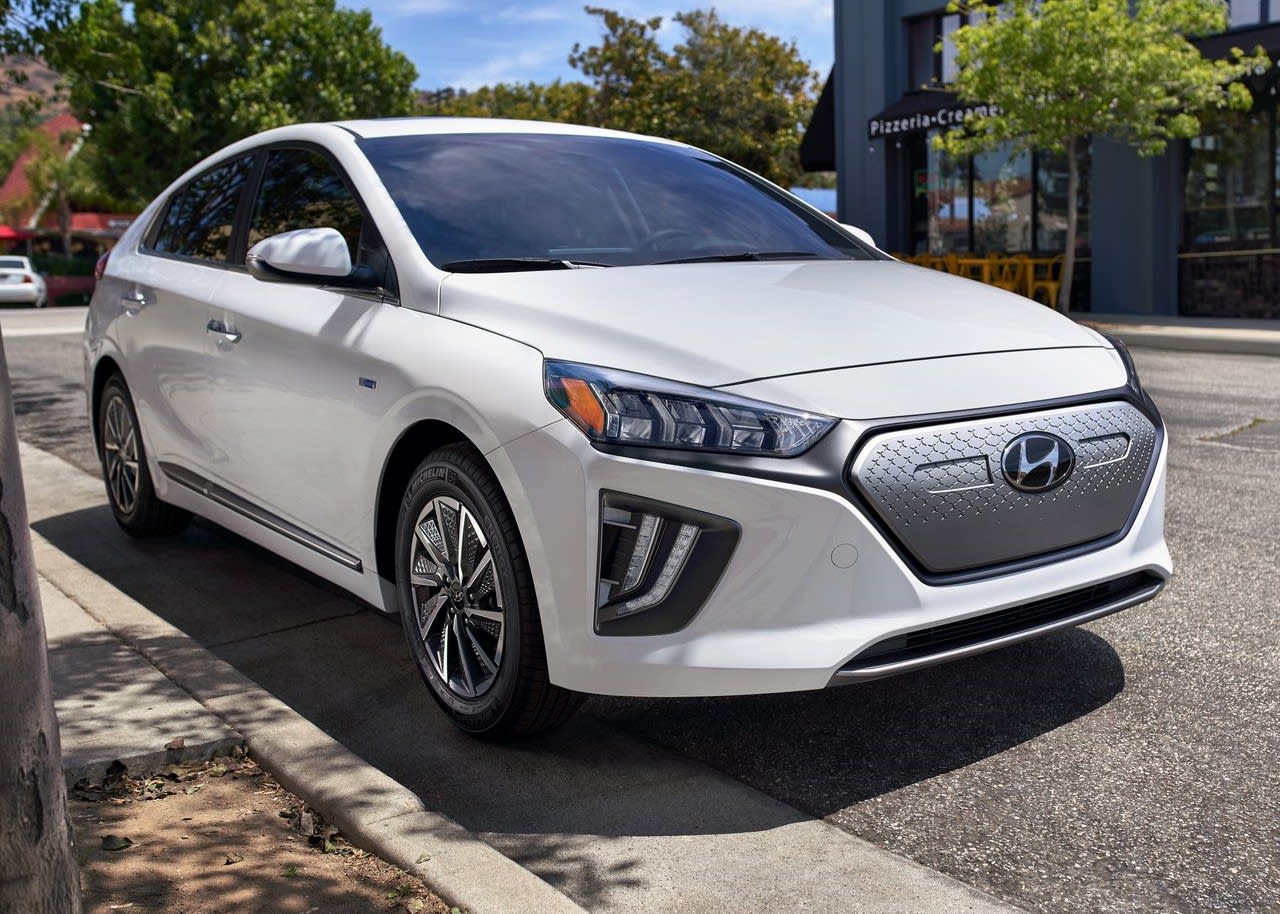
The Ioniq Electric was first introduced back in 2016 but was given a facelift in 2019, with sleeker looks and a bigger battery. It could be an option for someone looking for a practical, family car with zero direct emissions, but who isn’t interested in the current craze for SUVs. However, with a lot of rivals now available, it’s important to look at them too.
Key Features
Aside from the electric powertrain, which we’ll get to shortly, the Ioniq Electric promises plenty of interior space for the family and their luggage, thanks to its slightly unusual shape. The bulbous back end might not be to everyone’s taste, but it means extra luggage space.
Much of the modern tech you’d hope for is present and correct, including many that you might only expect on more luxurious and expensive cars. Alloy wheels, heated and ventilated seats, adaptive cruise control and full LED headlights are all available.
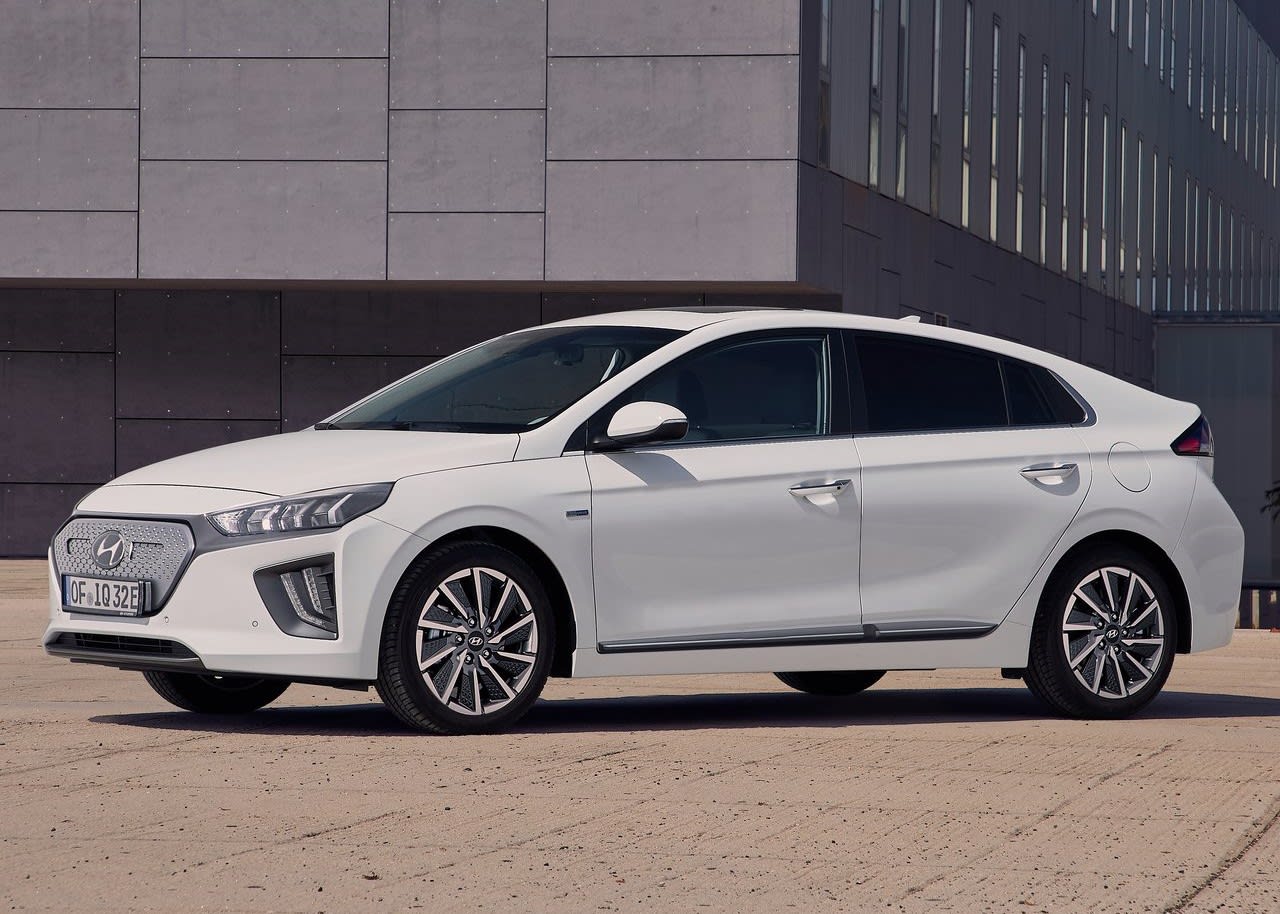
There’s just one power option and two trim levels to choose from, but they’re well equipped. All come with heated seats and a heated steering wheel, air conditioning and bright LED headlights, as well as adaptive cruise control and a rear parking camera with sensors. A big touchscreen infotainment system with full smartphone connectivity is included too.
Range & Batteries
The Ioniq Electric keeps things simple with a single power choice. It sports a 38.3kWh battery, which promises a range of up to 193 miles. That’s perhaps optimistic unless you have perfect conditions, but you should easily be able to get around 165 miles between charges in the real world. This makes it genuinely usable for decent-sized commutes, but there are rivals that will go even further without needing a top-up.
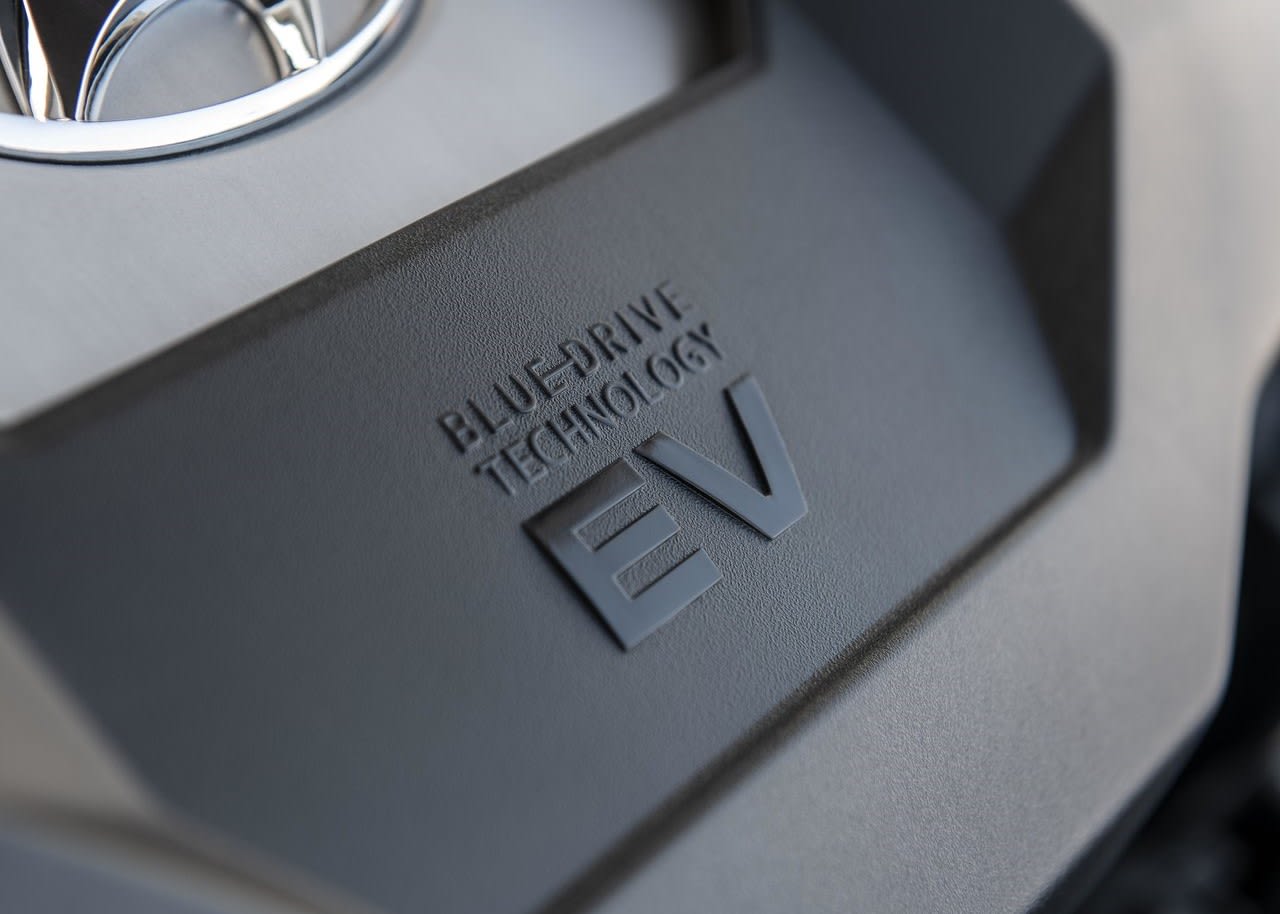
Performance & Drive
The Ioniq Electric’s motor puts out 136 horsepower. Compared to equivalent petrol or diesel cars, that doesn’t sound like loads, but with the instant response that electric motors give, it’s very brisk off the line. You can change modes between Eco and Sporty settings, which have the effect of limiting or maximising accelerator response, and when it’s in Sport it really shifts. Regular use of this mode will be lots of fun, but lessens the range somewhat. We’d advise sticking to the economical settings most of the time.
The nature of electric motors means that there’s not quite as much zip to the Ioniq at higher speeds, but it’s still more than capable of comfortable motorway speeds. At slower speeds you can ramp up the amount of energy recouped from cruising or braking, and this acts as a brake as the kinetic energy is scooped back into the battery. This means you can drive the car using only the right pedal. It takes some getting used to, but makes for very relaxed about-town progress. And of course, electric cars have no gears to shift.
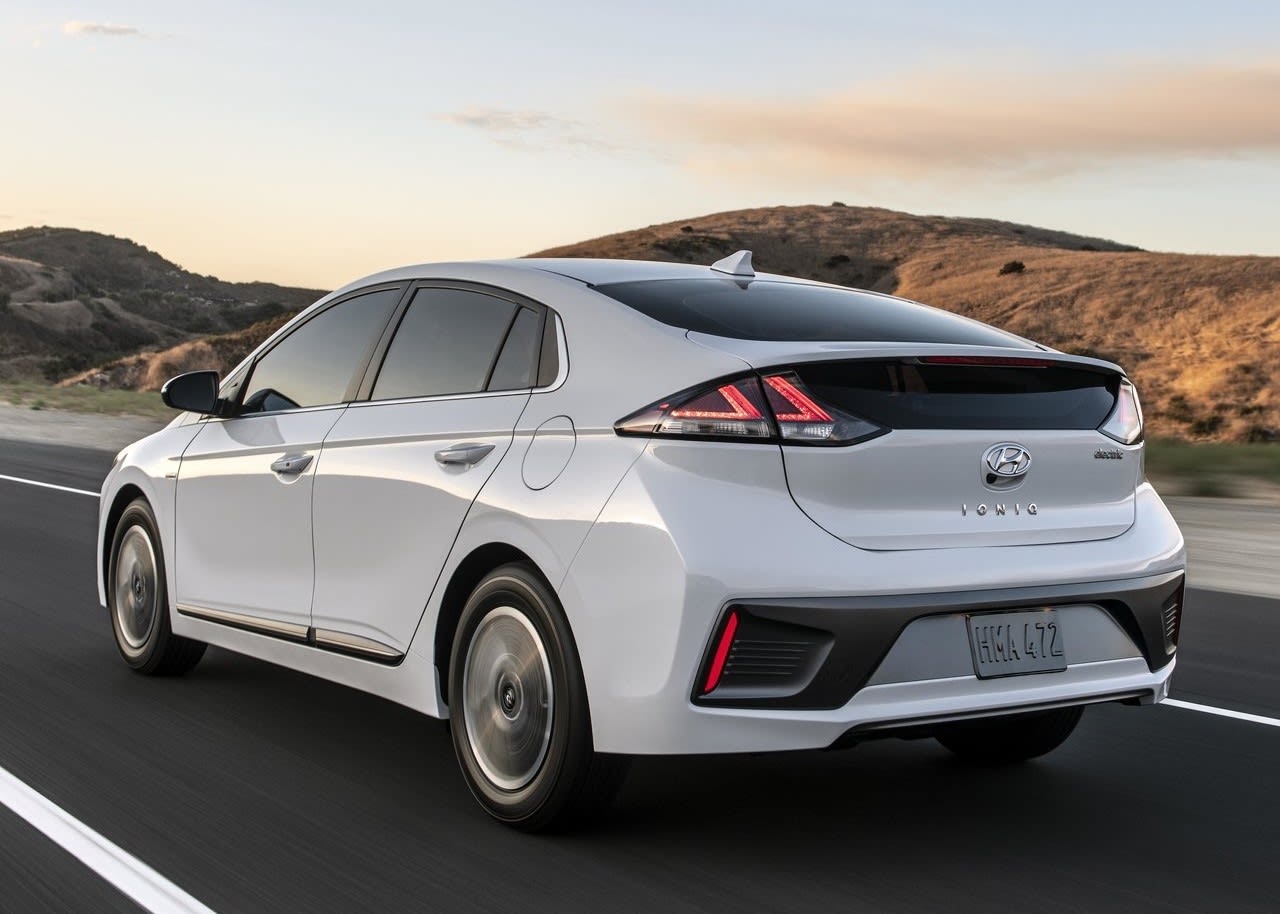
It’s quiet too, at low speeds at least. At higher velocities you won’t hear the engine (because there isn’t one), but you will pick up some road and wind noise. It’s all at acceptable levels though.
The Ioniq’s batteries are mounted low down in the car, which makes for a low centre of gravity and reasonable handling, but despite the zippy acceleration it’s not trying to be sporty. The steering is light and isn’t particularly sharp, so it’s not particularly fun to drive, but it is more than capable of cruising through bends with confidence, and the ride comfort is good too.
Charging
Lease an Ioniq Electric and you’ll be able to charge it using a 7.2kW home wallbox in just over six hours or to 80% in 47 minutes at a 50kW rapid charge station. Make sure you factor this in when planning longer journeys. Hyundai has included charging stations in the Points of Interest section of its sat-nav system.
You can check the level of charge without getting into the car, using either Hyundai’s Bluelink smartphone app, or by glancing at the three blue lights on the top of the dashboard that indicate whether or not the battery is full.
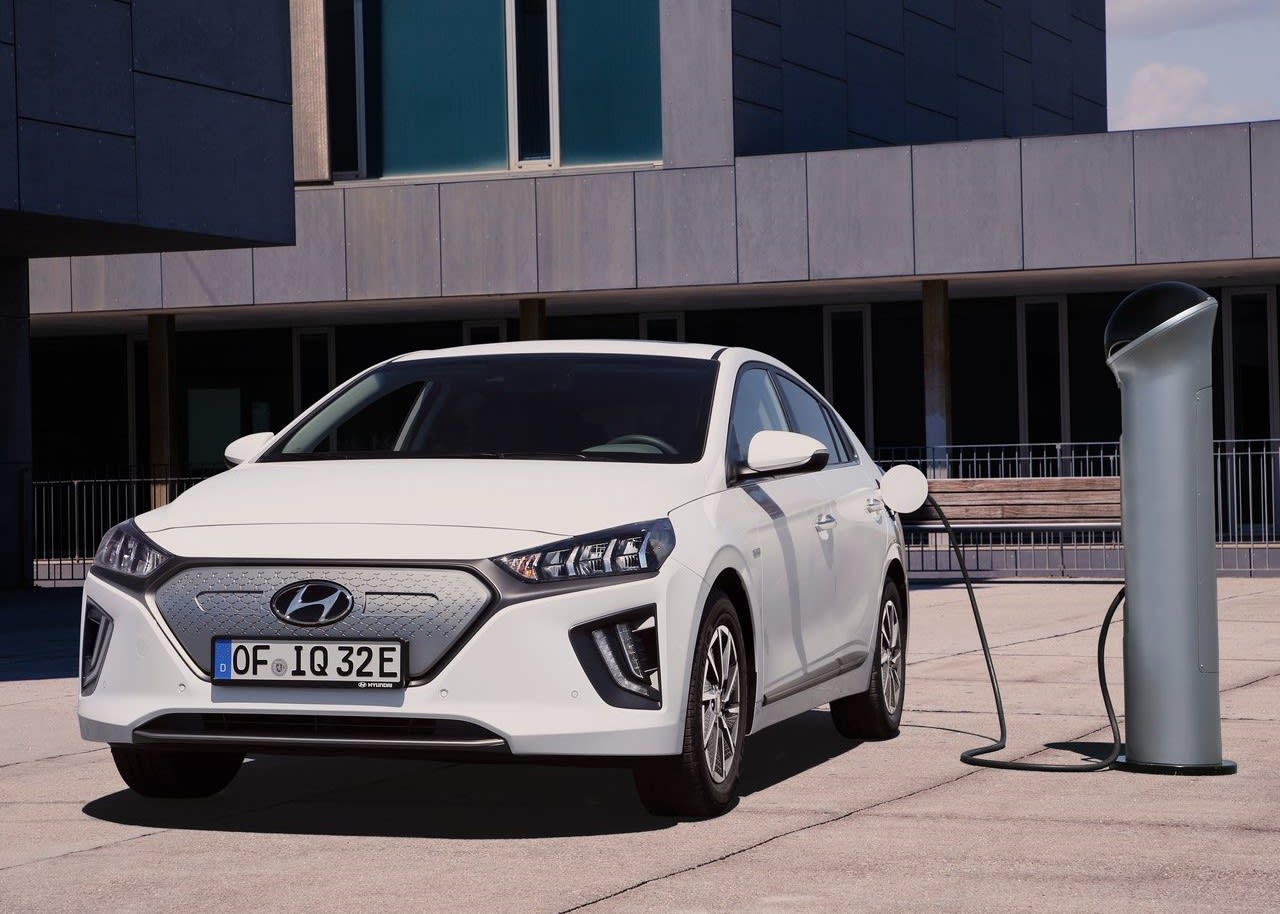
Should you find yourself without access to a wallbox or a public charger, a three-pin plug and cable are supplied, which you can plug into any regular outlet. Charging in this way will take 19 hours.
Running Costs & Emissions
Compare monthly leasing costs for the Ioniq Electric to some of its rivals, and they look rather high. You can get a larger Hyundai Kona Electric for less, and at the time of writing a Nissan Leaf is some £100 a month cheaper. A Volkswagen ID.3 and Citroen e-C4 are also more affordable. This suddenly makes the Ioniq less attractive, although it’s always worth keeping an eye on deals, as they can change over time.
Electricity will cost you far less than petrol or diesel, no matter how you charge your Ioniq. The most efficient way, however, will be at a home wall box, overnight while using a tariff that gives you cheaper off-peak electricity. Public rapid chargers will be more expensive.
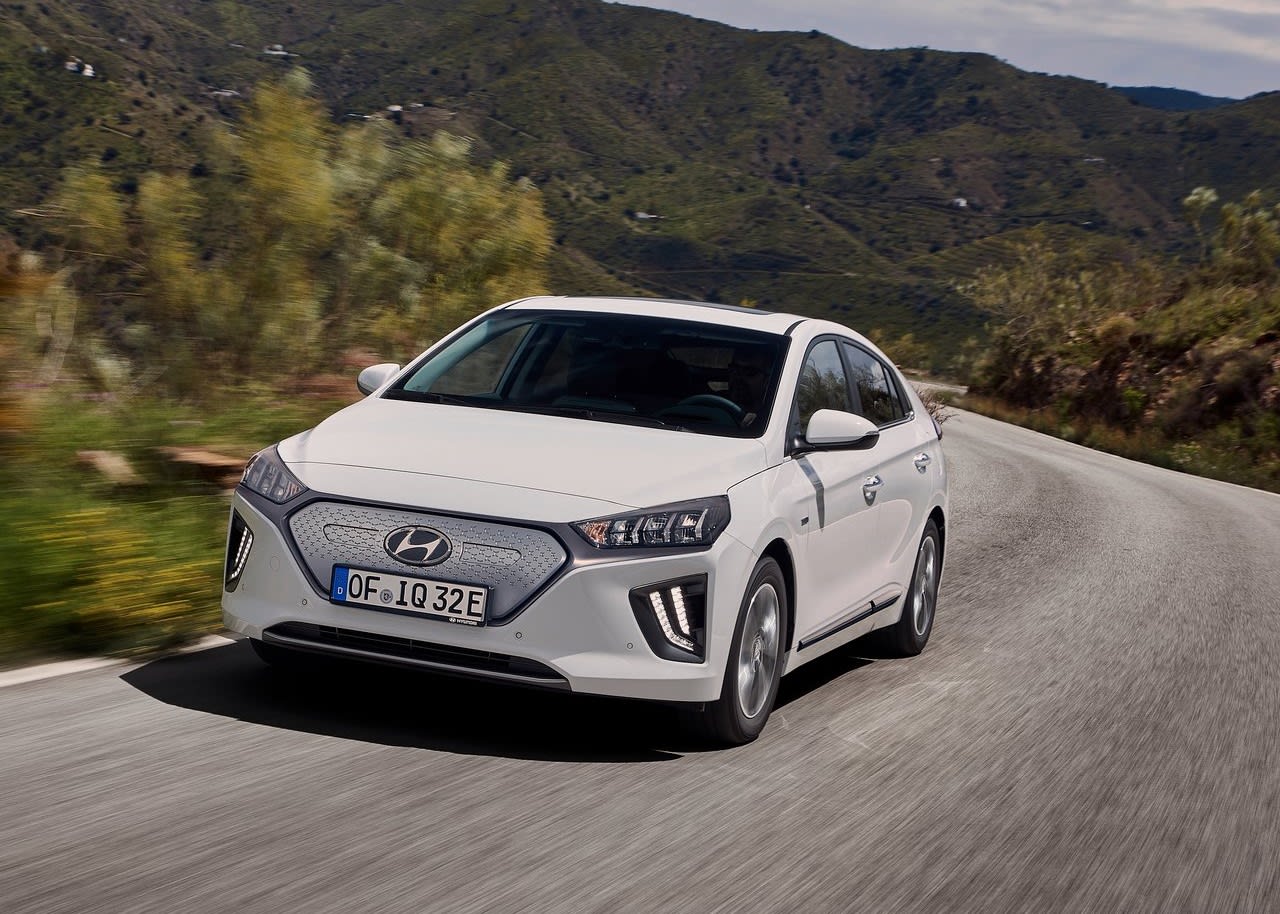
In terms of EV efficiency in miles per kWh (the equivalent of miles per gallon), you can expect up to 4.5 miles/kWh, which is very good, and better than almost all rivals. The only more efficient cars are much smaller.
Insurance groups are either 16 and 17 of 50, so insuring the Ioniq Electric won’t break the bank. There are no exhaust emissions from the Ioniq Electric as, well, it doesn’t have an exhaust. That’s great news for company car drivers, as benefit in kind tax will be just 1% for 2021/22. That’ll rise to 2% in 2022/23, but that’s still far less to pay than any petrol, diesel or hybrid car.
Interior & Technology
The Ioniq’s interior is unremarkable but inoffensive in terms of both design and build quality. It’s quite button heavy, which goes against some rivals that are embracing minimalism and using touchscreen for everything, but we think the buttons make it easier to change settings, especially while on the move.
The Ioniq uses gear select buttons rather than a gear stick, which might take a bit of getting used to when manoeuvring as you have to look down to shift between forward and reverse. The cabin plastics feel solid enough, but don’t have the premium feel that you might hope for in a car that has a list price of more than £30,000.

Visibility ahead is good. It’s harder to see out of the back, thanks to the split rear window, but all models have a rear parking camera and sensors. All models of Ioniq Electric are well kitted out with tech. You’ll get a 10.25-inch touchscreen with satellite navigation and a digital driver display instead of analogue dials. It’s not the flashiest system ever made but it’s easy to navigate and quick to respond, and it comes with Android Auto and Apple CarPlay for maximum smartphone connectivity.
You’ll also get a decent sound system with eight speakers and a wireless phone charger too.
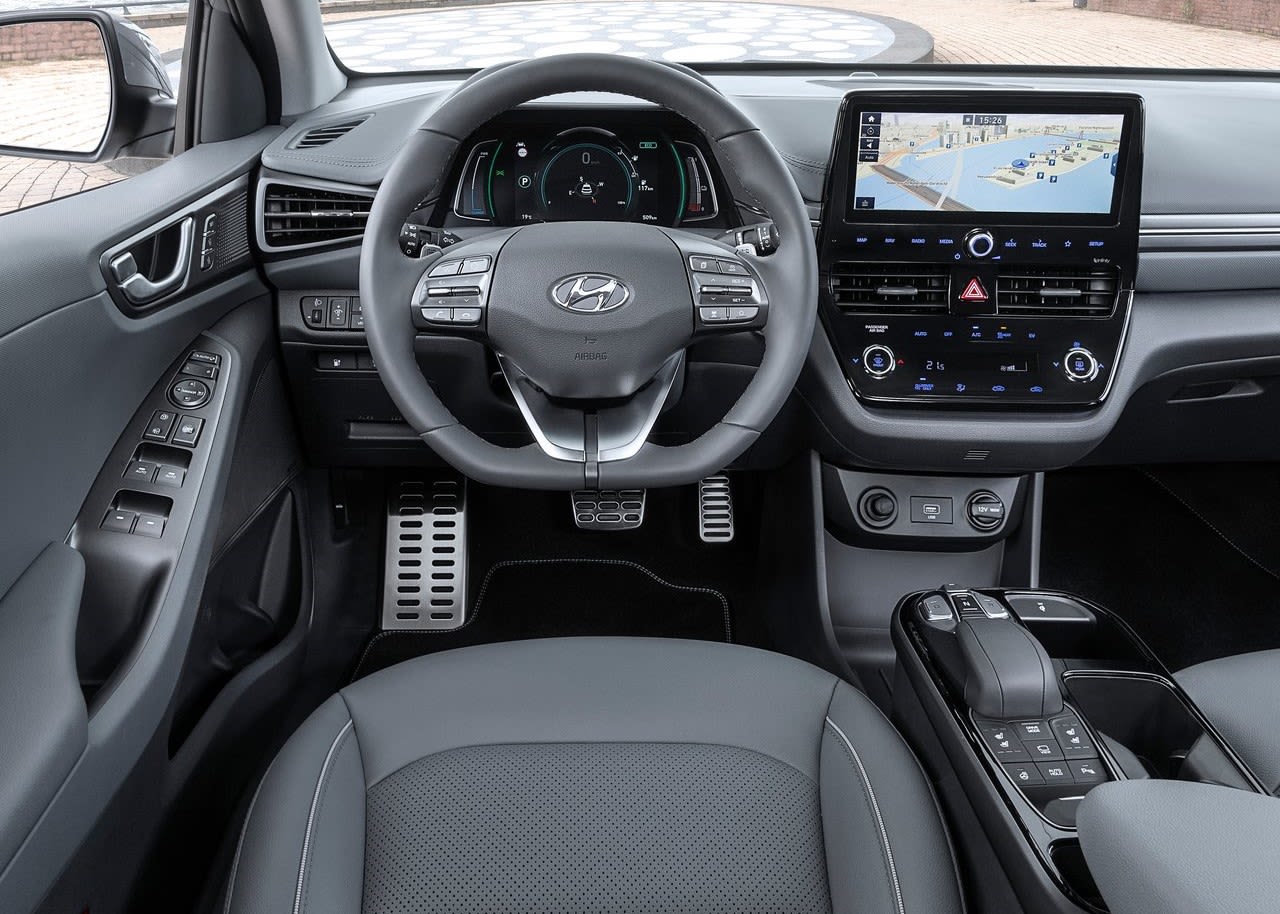
You can control and monitor certain settings on your Ioniq through a smartphone app. This will let you preheat the cabin on chilly mornings and even turn on the heated steering wheel. The app will also let you check how much power you have, lock or unlock the doors and send a destination to the sat-nav.
Practicality & Boot Space
Four adults should have no issues on long journeys in the Ioniq, although headroom will be tight in the back if you’re over six foot and five will be a squeeze. Leg room is reasonable, although the Nissan Leaf has more space.
At 357 litres, the boot is a decent size – bigger than the Hyundai Kona Electric SUV – but it is smaller than the hybrid and plug-in hybrid Ioniqs. Fold the rear seats down and it expands to 1,417 litres, which is a good space for larger bits of luggage.
There’s plenty of storage in the cabin, with two cupholders up front and a storage area in front if the gear select buttons, as well as a space under the centre armrest. The door pockets are a usable size too.
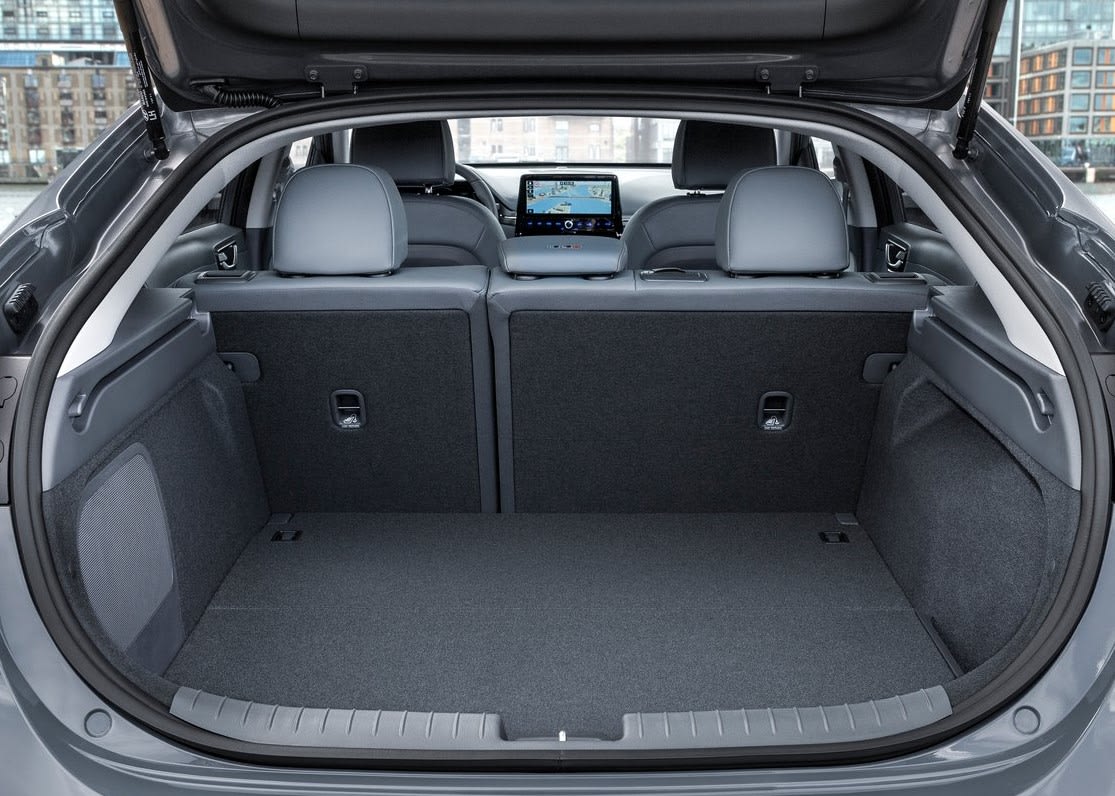
Safety
The Ioniq Electric hasn’t been tested by independent safety organisation Euro NCAP, but the very similar hybrid model has, and scored the maximum five-star score in 2016. All models of the Ioniq Electric come with automatic emergency braking, which will intervene if you don’t respond to an impending collision, and a lane keep assistance system too.
The Premium SE model gets a blind spot warning system and rear cross traffic warning, which will alert you to oncoming vehicles when you’re reversing out of a parking space.
All models get front, side and curtain and driver’s knee airbags and there are Isofix child seat mounting points on the outer rear seats.
Options
There are two trims available on the Ioniq Electric, called Premium and Premium SE. Premium might be the entry-level model, but it’s actually very well kitted out, and you’ll only really want Premium SE if you’re wooed by the extra niceties that it provides.
Both models ride on 16-inch alloy wheels and have climate control air conditioning and LED headlights, as well as adaptive cruise control and the same widescreen infotainment system.
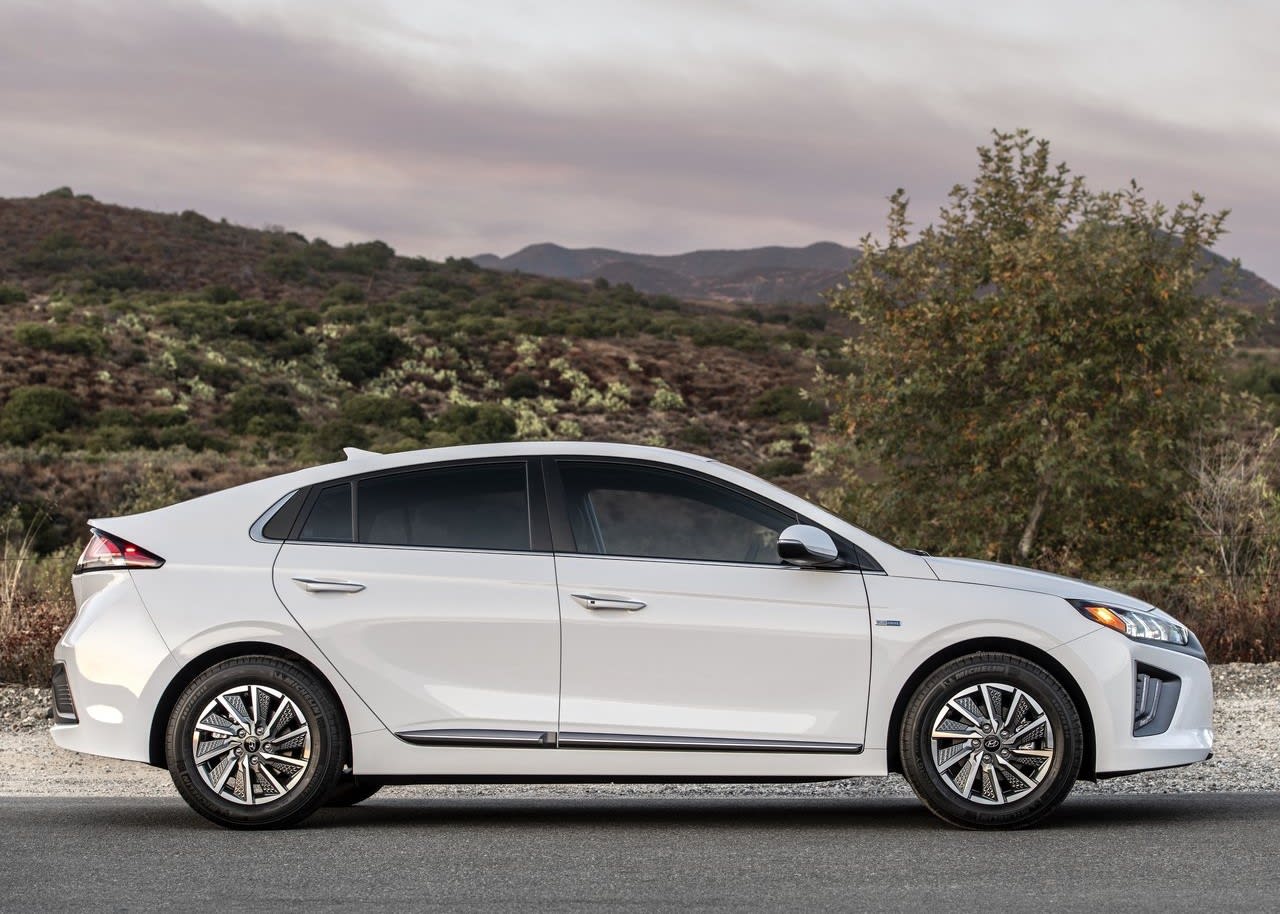
Upgrading to the Premium SE gets you ventilated, as well as heated front seats, which blows cold air through perforations to keep you cool on hot days. The driver’s seat is electrically adjusted, and there’s part-leather upholstery too. Other extras include a front window defogger, and heated rear seats.
Options are restricted to various special paint colours, which makes it much easier to decide which model you want without getting bogged down in the extras list.
Rival Cars
As the electric vehicle market expands at a rate of knots, there are plenty of rivals for the Ioniq Electric. This is a problem, as while the Hyundai was a pioneer in the UK electric market several years ago, there are now options that could prove more attractive.
In terms of similarly-sized rivals, look at the Nissan Leaf or the Volkswagen ID.3, but when you look at the leasing costs, you may well also be tempted by one of the many electric SUVs on the market. Hyundai’s own Kona Electric has impressively low leasing costs, as does the MG ZS EV. Kia’s e-Niro is an excellent car with more practicality than the Kona, and the smaller Kia Soul EV is very good too. Most of these offer a larger battery range.
Verdict & Next Steps
Several years after it was first introduced, the Hyundai Ioniq Electric is still a very decent car. It’s practical, drives well and has a reasonably large range between battery charges. But the problem for it is that there are more and more newer, better rivals, often at a lower monthly price. If you end up leasing an Ioniq Electric we suspect you’ll be very happy with it, but we’d urge you to check out the opposition first, as you’ll likely find something even better for your cash.
Where to next?
View latest Hyundai Ioniq Electric leasing deals - guide price from £271.20 per month inc VAT**
Looking for a great leasing deal? Check out our incredible range of car lease deals
New electric car? Read our latest Reviews and find the right model for you
Want to know more about leasing? Take a look at our comprehensive Leasing Guides
Interested in everything motoring? Why not catch up on all the latest Car Leasing News.
*Score based on Select’s unique meta score analysis, taking into account the UK’s top five leading independent car website reviews of the Hyundai Ioniq Electric
**Correct as of 08/06/2021. Based on 9 months initial payment, 5,000 miles over a 48 month lease. Initial payment equivalent to 9 monthly payments or £2440.80 Ts and Cs apply. Credit is subject to status.



















